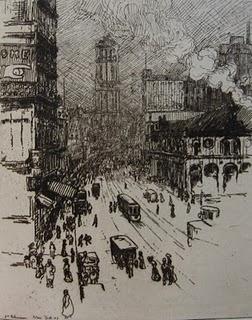 Jean-Émile Laboureur, Broadway, New YorkEtching, 1907
Jean-Émile Laboureur, Broadway, New YorkEtching, 1907My prints by Jean-Émile Laboureur include etchings, copper engravings, and wood engravings, made between 1907 and 1928. The earliest, an etched view of Broadway in New York, published by the Gazette des Beaux-Arts, is one of the products of Laboureur's early years in the United States, where he taught at the Art Student's League in New York, and made some striking etchings of both New York and Pittsburgh. In the period 1899-1911 Laboureur lived in Dresden, the USA, Canada, London, Italy, Greece, and Turkey, before returning definitively to Paris.
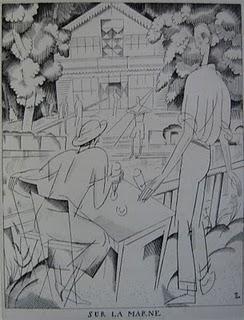 Jean-Émile Laboureur, Sur la MarneEngraving, 1924
Jean-Émile Laboureur, Sur la MarneEngraving, 1924 Jean-Émile Laboureur, Sur la TamiseWood engraving, 1924
Jean-Émile Laboureur, Sur la TamiseWood engraving, 1924Once back in Paris, Jean-Émile Laboureur made friends with the poet Guillaume Apollinaire and the artist Marie Laurencin, becoming Laurencin's tutor in printmaking. It was at this period that he really developed his own artistic style, though a catalogue of 1909 already lists 171 prints. In 1916 he turned to copper engraving, and this became his most distinctive and individual means of expression. His early wartime engravings, Petites images de la guerre sur le front britannique, made while serving as an interpreter for the British troops at the Western Front, are wonderfully-observed, and very much studies in manners rather than depictions of warfare. In style they are not unlike his 1924 engraving Sur la Marne, though of course the subject matter is entirely different. From the same year I have another scene of indolent pleasure-seekers disporting on a river, this time on the Thames. Both river scenes were published in Byblis.
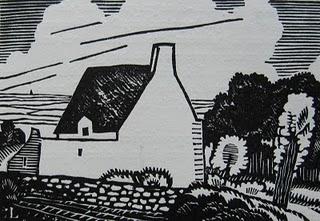 Jean-Émile Laboureur, PaysageWood engraving, 1922
Jean-Émile Laboureur, PaysageWood engraving, 1922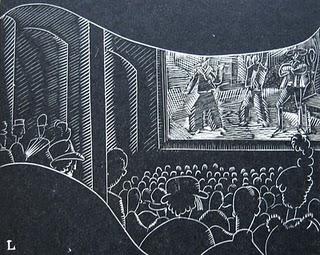 Jean-Émile Laboureur, Le CinémaWood engraving, 1924
Jean-Émile Laboureur, Le CinémaWood engraving, 1924The two small-scale wood engravings above were made for the annual almanachs of the Société de la Gravure sur Bois Originale, in which French wood engravers strove to impress each other with their virtuosity. The almanachs were issued in editions of only 160 copies.
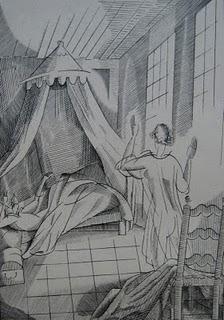 Jean-Émile Laboureur, Falling out of bedEngraving, 1925
Jean-Émile Laboureur, Falling out of bedEngraving, 1925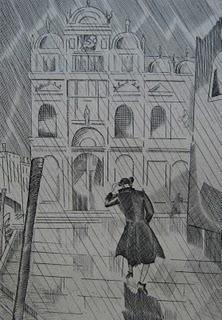 Jean-Émile Laboureur, Venice in the rainEngraving, 1925
Jean-Émile Laboureur, Venice in the rainEngraving, 1925My 1925 engravings of Venice come from one of 75 separate suites without text of Laboureur's illustrations for The Devil on Love by Jacques Cazotte. They were printed on Hollande van Gelder paper by Stanley Morison.
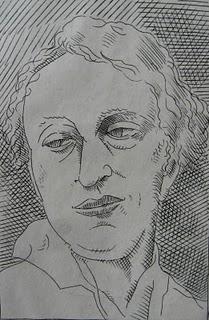 Jean-Émile Laboureur, Fernand FleuretEngraving, 1928
Jean-Émile Laboureur, Fernand FleuretEngraving, 1928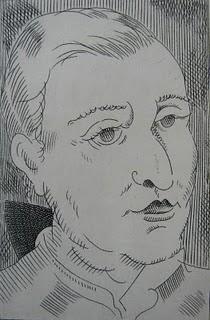 Jean-Émile Laboureur, Restif de la BretonneEngraving, 1928
Jean-Émile Laboureur, Restif de la BretonneEngraving, 1928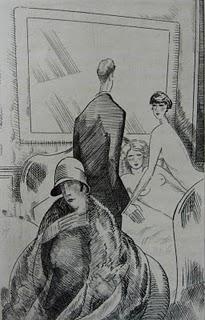 Jean-Émile Laboureur, Scene in a brothelEngraving, 1928
Jean-Émile Laboureur, Scene in a brothelEngraving, 1928These 1928 engravings were made for Fernand Fleuret's Supplément au Spectateur Nocturne, and include portraits of both Fleuret (another friend of Apollinaire) and the author to whose work he was supplying a modern twist, Restif de la Bretonne.
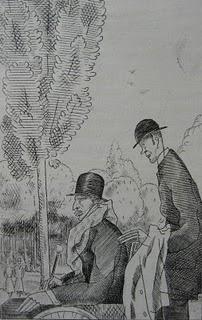 Jean-Émile Laboureur, Walk in the parkEngraving, 1928
Jean-Émile Laboureur, Walk in the parkEngraving, 1928There were major retrospectives of the art of Jean-Émile Laboureur in 1991 and 1996, both in his home town of Nantes. For much of the information above I am indebted to Janine Bailly-Herzberg's invaluable Dictionnaire de l'Estampe en France.

